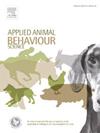联合强化:有毒的球杆还是现代马训练的灵丹妙药?叙述性回顾
IF 2
2区 农林科学
Q1 AGRICULTURE, DAIRY & ANIMAL SCIENCE
引用次数: 0
摘要
马行业的利益相关者已经确定,不适当的训练做法是对家马福利的重大关注。常见的马训练方法主要基于传统的做法,这些做法往往与马的目的性、行为学或认知不一致,因此,用于促进人马互动的技术值得关注。鉴于马术的社会许可目前的压力,是时候审查什么是目前已知的马行为矫正方法,并确定有知识赤字的领域。与其他动物物种对正强化的广泛依赖相比,在马的训练中,负强化是大多数人与马互动的基本基础,这在马的训练中是独一无二的。虽然正强化为动物训练提供了许多优势,但骑马的相互作用特征必然依赖于训练过程中厌恶刺激的使用,例如压力提示,即使强度很低。因此,一个结合了正强化和负强化的联合强化模型是否能够提供正强化的好处,同时适应来自负强化的压力线索,这个问题值得研究。这篇综述旨在概述当前的知识和应用联合强化在马训练文献与积极和消极强化模式的比较。对文献的调查强调了在训练中使用的不同形式的强化的描述和分类中的大量不一致。许多探索正强化的假设研究纳入了负强化的未被承认的方面,从而混淆了实验结果和结果的解释。因此,缺乏对这些方法实际上如何组成联合强化的具体关注意味着错过了在这一领域推进科学理解的机会。因此,关于联合强化的知识仍然很贫乏,而由正强化产生的训练方法和结果不一致或分类错误。这些不一致突出了有必要对联合强化的使用进行有针对性的研究,以更好地了解如何将基于奖励的训练计划纳入马匹训练,包括在骑马期间。本文章由计算机程序翻译,如有差异,请以英文原文为准。
Combined reinforcement: Poisoned cue or a panacea for modern equine training? A narrative review
Equine industry stakeholders have identified that inappropriate training practices are of significant concern for the welfare of domestic horses. Common approaches to horse training are largely based upon traditional practices, which frequently do not align with equine telos, ethology or cognition, and consequently, the techniques used to facilitate human-horse interactions warrants this concern. Given the current pressure on equestrianism’s social licence, it is timely to review what is currently known about equine behaviour modification approaches and identify areas where there is a deficit of knowledge. Uniquely in horse training, negative reinforcement is the fundamental basis for the majority of human-horse interactions, compared to the wider reliance on positive reinforcement in other animal species. While positive reinforcement offers many advantages for animal training, the characteristics of the ridden horse interaction necessarily relies on the use of aversive stimuli during training, such as pressure cues, even if of low intensity. Therefore, the question of whether a combined reinforcement model, incorporating both positive and negative reinforcement, can provide the benefits of positive reinforcement while accommodating pressure cues from negative reinforcement is worth investigating. This review seeks to outline current knowledge and application of combined reinforcement in the equine training literature for comparison with positive and negative reinforcement modalities. A survey of the literature highlighted a large number of inconsistencies in the description and classification of different forms of reinforcement used in training. Many studies putatively exploring positive reinforcement incorporate unacknowledged aspects of negative reinforcement, thereby confounding experimental outcomes and the interpretation of the results. Consequently the lack of specific focus on how these approaches actually consist of combined reinforcement has meant opportunities to advance scientific understanding in this area have been missed. As a result, knowledge of combined reinforcement remains poor, whilst training approaches and outcomes arising from positive reinforcement are inconsistent or incorrectly classified. These inconsistencies highlight the need for targeted research on the use of combined reinforcement, to better understand how to incorporate rewards-based training programs in horse training, including during riding.
求助全文
通过发布文献求助,成功后即可免费获取论文全文。
去求助
来源期刊

Applied Animal Behaviour Science
农林科学-行为科学
CiteScore
4.40
自引率
21.70%
发文量
191
审稿时长
18.1 weeks
期刊介绍:
This journal publishes relevant information on the behaviour of domesticated and utilized animals.
Topics covered include:
-Behaviour of farm, zoo and laboratory animals in relation to animal management and welfare
-Behaviour of companion animals in relation to behavioural problems, for example, in relation to the training of dogs for different purposes, in relation to behavioural problems
-Studies of the behaviour of wild animals when these studies are relevant from an applied perspective, for example in relation to wildlife management, pest management or nature conservation
-Methodological studies within relevant fields
The principal subjects are farm, companion and laboratory animals, including, of course, poultry. The journal also deals with the following animal subjects:
-Those involved in any farming system, e.g. deer, rabbits and fur-bearing animals
-Those in ANY form of confinement, e.g. zoos, safari parks and other forms of display
-Feral animals, and any animal species which impinge on farming operations, e.g. as causes of loss or damage
-Species used for hunting, recreation etc. may also be considered as acceptable subjects in some instances
-Laboratory animals, if the material relates to their behavioural requirements
 求助内容:
求助内容: 应助结果提醒方式:
应助结果提醒方式:


